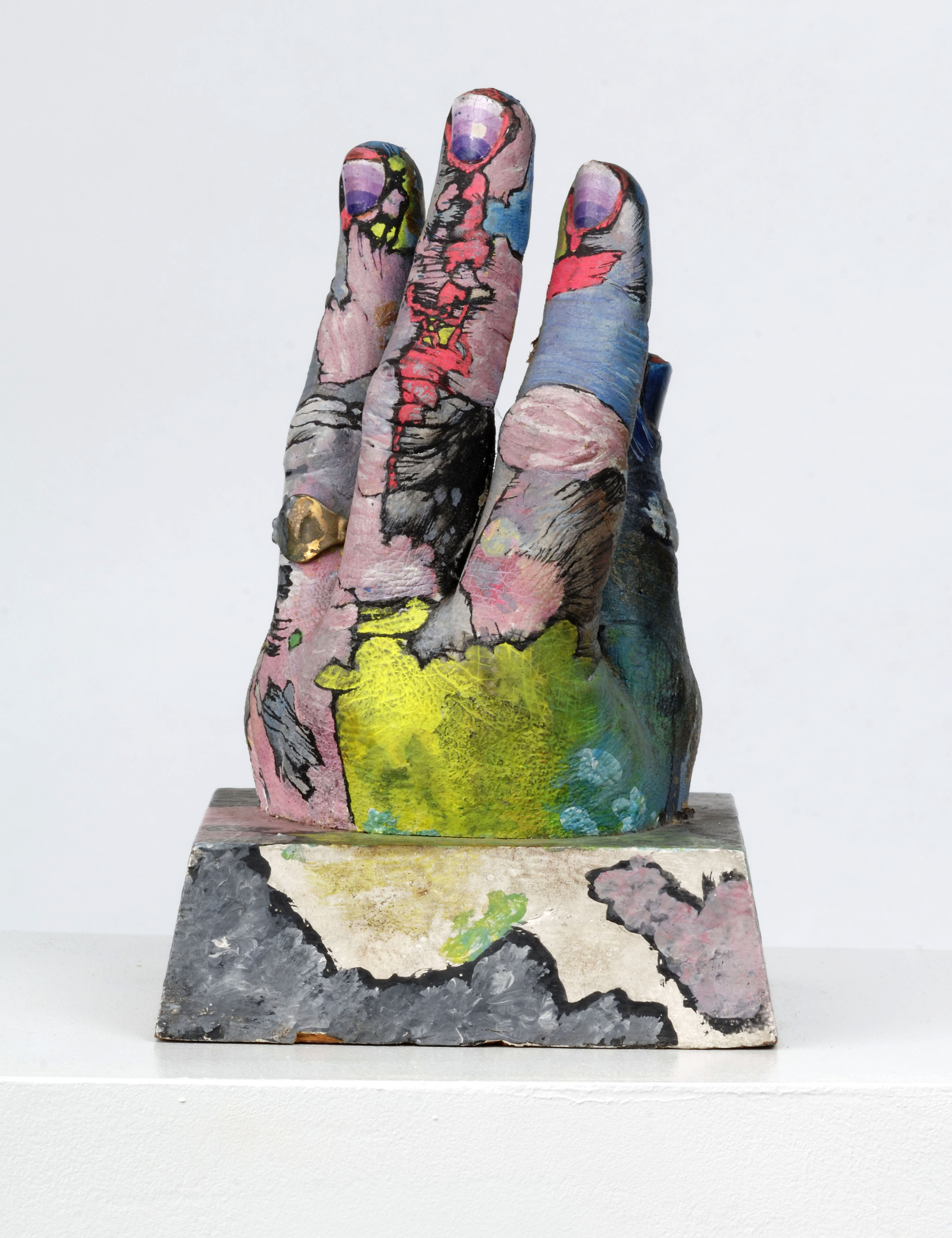The first major US retrospective featuring the works of artist Paul Thek comes to the Hammer Museum

“Untitled (Hand with Ring)” (1967) is among about 130 objects featured in the Hammer Museum’s latest exhibition, “Paul Thek: Diver, A Retrospective.” (Credit: Alexander and Bonin, New York)
Paul Thek: Diver, a Retrospective
Through Aug. 28
Hammer Museum, FREE for students
By Lauren Roberts
May 31, 2011 12:25 a.m.

Thek painted “Untitled (Diver)” (1969-1970) while living on the Italian island of Ponza. The work inspired the exhibition’s title, “Diver, A Retrospective.” (Credit: Alexander and Bonin, New York)
Beneath a painting of a solitary pink diver immersed in vivid blue, a journal lies open to an entry dated in 1975.
The page ““ titled “96 Sacraments” ““ offers an extensive prescription for living: to breathe, to touch the earth, to grow and ultimately to die.
Although it’s been nearly 23 years since Paul Thek’s passing, the spirit of the artist’s work is very much alive in “Paul Thek: Diver, A Retrospective.”
Journals, letters and photographs of the Brooklyn-born artist are displayed alongside Thek’s most infamous wax “meat piece” sculptures, as well as rare paintings and installations, some of which have never been seen in the U.S.
The UCLA Hammer Museum is the third and final stop for the show, which was co-organized by New York’s Whitney Museum of American Art and Pittsburgh’s Carnegie Museum of Art, the only other venues.
The retrospective is the first major U.S. exhibition dedicated to Thek’s work as a sculptor, painter and creator of elaborate installations.
The show opens with reference to Thek’s emergence in the 1960s alongside contemporaries like pop artist Andy Warhol. A black-and-white screen test featuring the young Paul Thek is projected against the gallery wall, the remains of one of Warhol’s unfinished film projects.
“When we first set up the show in New York, I kept feeling like Thek was watching us from another realm, making sure it was all right,” said Lynn Zelevansky, co-curator of the exhibition and director of Pittsburgh’s Carnegie Museum of Art.
The exhibition is organized chronologically, beginning with Thek’s startlingly realistic 1960s “meat piece” sculptures, which he grew to call “technological reliquaries.”
The early pieces range from glistening wax slabs of meat to later wax and plaster casts made from Thek’s own body.
According to Zelevansky, the pieces pose a critique of the contemporary art world and of minimalist art, which Thek saw as bloodless and soulless.
“The thing that seemed to bother (Thek) was that the art world seemed to be moving forward as if we weren’t made of flesh and blood and weren’t eventually going to die,” Zelevansky said. “So for him, that’s a very important aspect to his work.”
Wax and plaster cast limbs are intricately painted, down to the violet fingernails. They are placed on pedestals and enclosed in plexiglass.
“Many of them are incredibly vibrant in their colors, way beyond the norms of good taste ““ putrescent or almost phosphorescent color choices,” said art history Professor George Baker, who also wrote an essay on Thek for the exhibition catalogue.
“They begin to evoke psychedelic art in a way that you don’t see many avant-garde artists of the ’60s forthrightly beginning to interact with what became psychedelia, hippie culture.”
Despite Thek’s early connection to Warhol, he is widely regarded as a forgotten artist. After first showing his “meat pieces” in New York, Thek left the U.S. He spent much of his career in Europe, including the Italian island of Ponza, where he painted the diver from which the exhibition takes its title.
It was while abroad that Thek began working in artists’ collectives, making installations and collaborative art in addition to his painting.
“Thek was forgotten. He paid the price, but he also reaped the rewards,” Baker said.
“He lived a very interesting life during this moment and created ways of working as an artist that no one else was really imagining ““ working in collectives, working with groups. … It was very utopic, very anti-commodity, anti-market, anti-hegemonic culture. … He was looking for a new way that artwork could engage with new ways of living.”
According to Elisabeth Sussman, co-curator of the exhibition and curator of photography at the Whitney Museum of American Art, when Thek returned from Europe in the late 1970s, the U.S. was in the throes of a painting revival known as “neo-expressionism.”
Thek, who had trained as a painter in art school, took interest in the New York art scene and began incorporating vibrant color and writings, much like his journal entries, into his painting.
One violet canvas dated 1985 instructs to “afflict the comfortable, comfort the afflicted” in painted yellow handwriting. Another from 1987 reads, “While there is time, let’s go out and feel everything,” amid a sea of quick turquoise paint strokes.
“He couldn’t afford a big studio, so he could never do the sort of large-scale figurative painting that was the talk of the town in that decade (1980s), so these were all small. And he was broke … so these paintings were cheap, they have cheap frames and everything about them is cheap and quick,” Sussman said. “(But) these little paintings are kind of his way of saying, “˜This is my painting, take it or leave it.'”
The exhibition concludes with work Thek completed just before his death in 1988 after complications with AIDS. He died before the close of his last New York gallery show.
“There is some power left in just color, paint and objects made by hand,” Baker said. “They do something that no other kind of object in our culture does, and I think Paul Thek found a way to make that position clear and beautiful without selling out.”


